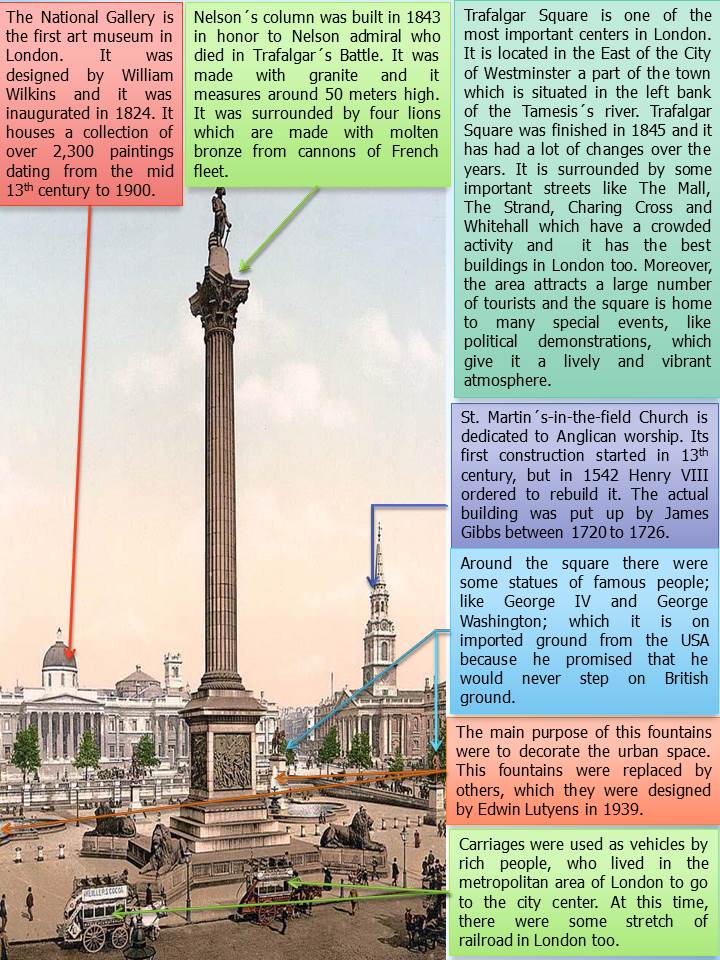LONDON (19th century)
This picture portrays one of the most important places in London: Trafalgar Square. This image was made in 1890; by this time Britain had become the world´s first industrial society. Although the author of this picture is unknown, I have found it in a website about old pictures of important cities in Europe. Nowadays, this drawing is used for decorating house walls. Moreover, it is a good portray because it focuses on the historical monuments and social activities during the end of the 19th century in London.
Trafalgar Square, which was designed in 1825 and it was finished in 1845, is located in the East of the City of Westminster and bordered on all sides by other conservation areas. The City of Westminster appeared in the 11th century, when King Edward the Confessor began the construction of an Abbey at Westminster. Between the river and the Abbey he built a palace too, which is the seat of the Government. For centuries, the City of Westminster and the City of London were geographically quite distinct, until the 19th century when it was a big urban sprawl. The present-day City of Westminster as an administrative entity with its present boundaries dates from 1965, when the City of Westminster was created from three metropolitan boroughs: St Marylebone, Paddington, and the smaller Metropolitan Borough of Westminster, which included Soho, St. James’s, The Strand, Westminster, Hyde Park… This re-structuring had the main purpose of reducing the number of local government districts in London. This borough has both shopping areas like Oxford Street and Regent Street as important cultural monuments like Piccadilly Circus, Westminster City Council and Trafalgar Square.
This image shows very important monuments of London such as the National Gallery, Nelson´s Column, St. Martin in the Fields Church and other elements located on this place. Despite London being the world´s first industrial society in 1890, there was a lot of poverty downtown whereas rich people usually lived in suburbs outside the city walls. Rich people usually went to Trafalgar Square for shopping and cultural activities so this square turned into the commercial and cultural centre of London. That is why the streets, which lead up to the square, are wide and also have a bustling activity. Moreover, one of the streets that leads up to the Square, Charing Cross, has had an important train station since 1864. As a consequence, Trafalgar square and this street had a great economic activity in 1890, because they received a great amount of tourists and people who travelled from one place to another and slept near the station. Therefore, this zone had a lot of shops, restaurants, hostels and carriages which worked like taxis too. Despite the fact that Trafalgar square is rectangular; the town planning in the surrounding area is irregular; especially this part, because it is one of the oldest areas in London, which grew around the Thames´s banks. This river and the city wall have protected London from invasions until its destruction.
The two most famous landmarks in this square are the National Gallery and Nelson´s Column. Firstly, the central part of the picture is the Nelson Column which was designed by William Railton at a cost of £47,000. Its construction finished in 1843 but the four bronze lions on the base were added in 1867 and they were designed by Sir Edwin Landseer. The column also had a symbolic importance for Adolf Hitler; that is why if Hitler’s plan to invade Britain (Operation Sea Lion) had been successful, he would have planned to move the column to Berlin. Secondly, in the background of the picture we can find The National Gallery; this is the first art museum in London and it is the fourth most visited art museum in the world. This museum keeps a big amount of European paintings from 1250 to 1900.
Besides that, in the North-East corner of Trafalgar Square we can see St. Martin in the Fields Church, which, since its first construction in the 13th century, has had a lot of changes. The church is rectangular in plan, with the five-bay nave divided from the aisles by arcades of Corinthian columns, it has a beautiful vaulted ceiling too. St. Martin in the Fields Church has a proud history of hosting some of London’s best live classical music events as well as being an Anglicanism symbol, the main religion in Britain since the 16th century. Finally, other important elements here are the fountains and the statues around the square. The two fountains, which were planned when the square was laid out in 1840, were not aesthetic. These fountains were bought by the Government of Canada; when they were replaced by others designed by Sir Edwin Lutyens. Also, the square has many statues of famous people such as Edward Jenner, who discovered “the vaccination”; the Major-General Sir Henry Havelock and George Washington.
It is curious to note that Trafalgar Square was once famous for its feral pigeons, and feeding them was a popular activity; but then authorities forbid it for sanity problems; thus today, there are few birds in Trafalgar Square. Nowadays, Trafalgar Square is used for political demonstrations, sports events and a Christmas ceremony which takes place here every year since 1947. To conclude, I wanted to highlight with this writing the importance of Trafalgar Square in the economic and social activities over the years.
Esperanza del Val Benítez

